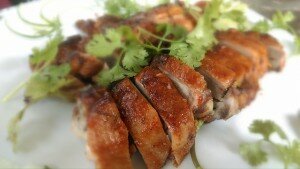 So I wound up cooking duck a couple of days ago, and now I can’t stop thinking about it. Sooooooo here we go.
So I wound up cooking duck a couple of days ago, and now I can’t stop thinking about it. Sooooooo here we go.
It’s the new year, and you know what that means. It’s the season for red, for hearts and cardboard cutouts of cherubs and chocolate. It’s Valentine’s Day, folks, and it’s time to get your butt in gear and learn some fancy tricks in the kitchen.
Now, there’s no one set way to lay down the perfect romantic meal for your mate, mostly because everyone’s different and everyone likes different things. That being said, I’ll share with you guys some of the things that make a meal with my girlfriend special, and maybe it’ll spark some ideas of your own.
I don’t know why, but there’s just something about a perfect medium-rare duck breast that screams romance to me. It’s a luxury food, something you don’t even think about eating on a daily basis. And with good reason – good duck, with its rich gamey flavor and mind-blowing, savory fat content, comes with a hefty price tag, and is daunting to prepare. Let’s see if I can’t take a little of that edge off.
- Score the skin. Using a sharp paring knife, slice thin cuts across the top of the breast at half inch intervals, cutting through the skin but not all the way through the fat to the flesh below. If you go light and don’t break the skin or go hard and cut into the meat every once in a while, don’t sweat it. Just as long as the majority of the cuts are only fat-deep. If you want to get even fancier, crosshatch the cuts in the opposite direction.
The utility of this step is two-fold. One, skin naturally shrinks. I could talk about how the proteins of the dermis and the epidermis react at two different temperatures blah blah blah, but the end result is that if you leave the skin entirely intact, it’ll bunch up and get all weird on you. Scoring it allows it to shrink while still pretty much staying in place. Two, all the excess exposure allows the fat to render faster. This is a good thing, I promise. The more the fat renders out, the more it can heat up and get that skin nice and crispy.
- Keep seasoning simple. Duck’s natural flavor is a stark contrast to chicken; it’s bold, earthy, and sweet. Don’t worry about concocting some kind of magical spice rub when a healthy dose of salt and pepper will do just fine.
- Start in a cold pan, skin side down. Ordinarily, starting any meat in a cold pan is a bad idea – protein loves to stick to metal while it’s heating up. In fact, the reason why most recipes call for a hot pan and oil is because if you can fast forward the cooking process to where the proteins glom onto each other and not the metal, you can keep them from sticking. We will not do this here for two reasons. One, duck skin, one of the greatest things you can eat on this Earth, requires delicate handling to reach its maximum deliciousness. Two, the runoff fat from the cooking process will be enough to lubricate the pan. All you have to do is believe.
- Bring it up to medium heat and hit the timer. Now, in my kitchen on my stove in my heavy-bottomed skillet, to get that sweet spot between rare and medium rare, a 1 lb. duck breast stays just below medium for 12 minutes. This stretch of time feels like parenting – you want to tend to it without being intrusive; guide it without shoving it. Check the underside as you go – you want the skin to reach a deep brown, like old wood or the outside of a loaf of bread. If it’s getting too dark too quickly, dial down the heat. If you hear a lot of sizzling before the fat has the chance to render, dial down the heat. Stay calm and be careful. This step takes between 12 to 15 minutes, and when you’re done, you should have a pool of clear duck fat and a nicely bronzed duck breast.
- Flip and cook for one minute. No more, no less.
- Remove from heat and wrap in foil for a minimum of five minutes. You know meat needs to rest, and you probably know why. This goes for any and all meats, and duck breast in particular. Part of the sublime joy of duck is the ludicrous juiciness of it, and letting it rest is integral in maximizing your return.
- If you’re going to carve it, use the sharpest knife you have and cut with the skin side down. Remember that the skin is now nice and crispy, which means getting a knife through it with any kind of regularity is going to be pretty tricky. Better instead to approach it from the softer, fleshier side, where you can make even, straight cuts without worry.
After that, you’re on your own, but for a couple of pointers. If you’re going to sauce, don’t cover up that beautiful skin or rosy pink flesh. Lay down a pool and arrange the duck on top. And add some color to that plate, would you? You’ve already got a sea of reds and browns, try adding some green to the plate (like minced parsley or a chive oil or sweet pea risotto). And stop using that powdered hot chocolate mix; it’s Valentine’s Day. Just drop a square of really good chocolate into a mug and pour hot milk (or half-and-half if you’re feeling saucy) over it.
And don’t be afraid to make a fruit sauce! Peaches or blueberries or orange. Okay, I’ll shut up now. Seriously.
Happy Valentine’s, guys. Just remember, no matter what you prepare for dinner, if it’s made with love, it’s special. Everything else is just icing on the cake.


















No Responses to “Romantic Duck with Love”